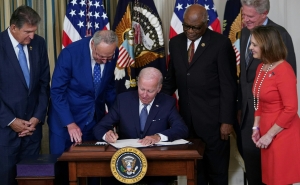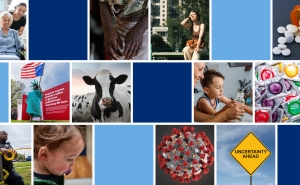How to Save a Life Using Naloxone
Carrying naloxone can help prevent opioid overdose deaths.

Naloxone, packaged with instructions, is one of the items given out by the Baltimore Harm Reduction Coalition outreach workers. Amy Davis/Baltimore Sun/Tribune News Service via Getty
Last month the CDC reported a surprising decline—approximately 10.6%—in drug overdose deaths. But the U.S. opioid crisis remains dire. “There has been a massive increase in overdose deaths in the last two decades,” says Carl Latkin, PhD, vice chair and professor in Health, Behavior and Society.
For each of the last three years, roughly 100,000 people have died from a drug overdose in the U.S. Around 75%—80,000—of those deaths involve opioids of some variety, Latkin says. But many of those deaths could be prevented by the naloxone administration, he adds.
Available in all 50 states, Washington, D.C., and Puerto Rico, naloxone is an easy-to-use medication that can prevent death from opioid overdose, if it can be given in time.
“We need [naloxone] to be everywhere, and for everyone to know how to use it,” says Travis Rieder, PhD, MA, an associate research professor at the Berman Institute of Bioethics.
Carrying naloxone can prepare you to save a life. Here’s what you need to know about it, and how to use it.
What is naloxone?
Naloxone is a medicine that rapidly reverses an overdose from opioids—including heroin, fentanyl, and prescription opioid medications. It is not a long-term treatment for opioid use disorder, and it will have no effect on someone who does not have opioids in their system.
There are two forms of naloxone that anyone can use without medical training or authorization: a prefilled nasal spray and an injectable. Both are small and easy to carry.
How does it work?
Naloxone is an opioid antagonist: It attaches to opioid receptors in the brain and reverses and blocks the effects of opioids.
Opioids are potentially fatal because, as a side effect, they suppress a person’s breathing, slowing or possibly stopping it entirely if overdose occurs. Naloxone can quickly restore a person’s normal breathing within two to three minutes.
Why should I carry naloxone?
Bystanders can be instrumental in preventing an overdose death: A 2018 CDC study found that in over 40% of opioid overdose deaths, a bystander was nearby—and nearly 19,000 lives could have been saved had they administered naloxone.
“Everyone should carry naloxone whether you use opioids or not, because you never know who may experience an opioid overdose—in a movie theater, grocery store, or in your neighborhood,” says Karin Tobin, PhD ’04, MHS ’00, professor in Health, Behavior and Society.
Is carrying naloxone essential for certain populations?
Just as someone with a high risk of allergic reaction might carry an epinephrine auto-injector (commonly known by the brand name EpiPen), carrying naloxone provides an extra layer of protection for those at a higher risk for overdose.
People who should both carry naloxone and keep it at home:
- People and relatives or friends of people experiencing opioid use disorder.
- People who are taking high-dose opioid medications prescribed by a doctor.
- People who use opioids and benzodiazepines together.
- People who use illegal opioids like heroin or fentanyl.
Because you can't use naloxone on yourself, let others know you have it in case you experience an opioid overdose.
Where can I get it?
Naloxone is available in all 50 states, Washington, D.C., and Puerto Rico, and may be purchased online or over the counter at many pharmacies, gas stations, and grocery or convenience stores. It usually costs no more than $50.
Naloxone is also often available from health departments, community-based naloxone programs, and many syringe service programs. If you have been prescribed high-dose opioids, talk to your health care provider about co-prescribing naloxone (some states require this).
“The increased availability of naloxone is a contributing factor to the reduction in overdose deaths,” says Tobin.
How do I know when to administer it?
Naloxone won't harm someone if they're overdosing on drugs other than opioids, so it's always best to use it if you think someone is overdosing.
The CDC lists the signs of an opioid overdose as:
- Unconsciousness or inability to awaken.
- Slow, shallow, or erratic breathing, or signs of difficulty breathing.
- Choking/gurgling/snoring sounds from a person who cannot be awakened.
- Discolored skin (especially in nails or lips). For lighter skinned people, the skin appears blue/purple, for darker skinned people, it appears gray or ashen.
- “Pinpoint pupils” that are small, constricted, and don't react to light.
If a person is unresponsive, grind your knuckles into their chest bone for five to 10 seconds. If they still do not awaken, proceed to administering naloxone.
How do I use it?
Naloxone is easy to use and can be given without any medical training.
If you suspect a person has overdosed based on the symptoms listed above, and have tried unsuccessfully to wake them , check their breathing.
If they're breathing less than once every five seconds, or if they're not breathing at all, explain loudly and clearly that you're going to give them naloxone. If someone else is there with you, have them call 911. Then, if you can, roll the person onto their back.
For spray naloxone:
- Peel back the foil on the package and remove the nasal spray.
- Hold it with two fingers on either side of the nozzle.
- Gently insert the nozzle into their nostril.
- Press the plunger all the way in until it clicks.
For injection naloxone:
- Take the cap off of the vial.
- Stick the needle through the rubber stopper.
- With the vial upside down, pull back the plunger to draw the correct amount of fluid into the needle. Keep in mind that a naloxone vial may be single or multidose.
- Be sure the syringe fills with liquid—not air.
- Inject the needle straight into muscle in the shoulder (like a flu shot) or into the front of the thigh (through the clothing if necessary).
- Push down on the plunger to empty the syringe.
What should I expect/do after administering it?
To prevent choking, roll the person onto their side with their knee and their elbow out in front of them. If you're alone with the person who's overdosed, now you can call 911.
If the person is still breathing less than once every 5 seconds, perform rescue breathing:
- Roll them onto their back.
- Use a breathing barrier rescue mask if you have one.
- Tilt their head back and lift their chin, opening their airway.
- Pinch their nose closed and give one breath slowly, watching to see their chest rise.
- Continue giving one breath every five seconds. If you hear gurgling sounds or they start to breathe deeply on their own, stop and roll them onto their side.
Wait two to three minutes after administering naloxone to see if normal breathing returns before giving a second dose—which may not be necessary. If you do need to give more when using spray, use the other nostril in case the first nostril was blocked.
When the person regains consciousness, try to keep them awake and breathing. They may be confused and disoriented. Take a step back and calmly explain that you have administered naloxone.
Make sure they remain on their side to prevent choking. Stay with the person until emergency assistance arrives.
Where can I learn more?
If you have further questions or would like more information about naloxone, contact your health care provider, or refer to the CDC’s naloxone page.
If you are struggling with opioid use disorder, help is available. Visit the CDC's page on treatment here, SAMSHA's national helpline page, or check out these harm reduction resources: NEXT Distro and National Harm Reduction Coalition.
Morgan Coulson is an editorial associate in the Office of External Affairs at the Johns Hopkins Bloomberg School of Public Health.


